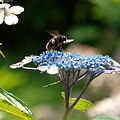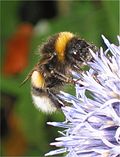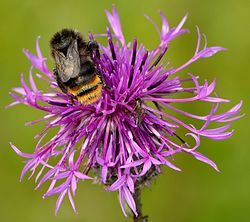| Name | Taxon name | Habitat | ITIS TSN | Image |
|---|
Rusty patched bumble bee  | Bombus affinis [5] (1863) | North America | 714782 [5] |  |
|---|
Cryptic bumblebee  | Bombus cryptarum (Johan Fabricius, 1775) | | 1126452 [5] |  |
|---|
Franklin's bumblebee  | Bombus franklini [5] (Theodore Frison, 1921) | | 714804 [5] |  |
|---|
Short-tongued bumblebee  | Bombus hypocrita [5] (Theodosio De Stefani Perez, 1905) | | 714927 [5] | |
|---|
Bombus ignitus  | Bombus ignitus [5] (Frederick Smith, 1869) | | 714928 [5] |  |
|---|
Bombus jacobsoni  | Bombus jacobsoni (Alexander Stepanovich Skorikov, 1912) | | 1126453 [5] | |
|---|
Bombus lantschouensis  | Bombus lantschouensis [7] (Oskar Vogt, 1908) | | 1126454 [5] | |
|---|
Bombus longipennis  | Bombus longipennis (Heinrich Friese, 1918) | | 1126455 [5] | |
|---|
White-tailed bumblebee  | Bombus lucorum [5] (Carl Linnaeus, 1761) | | 714816 [5] |  |
|---|
Northern white-tailed bumblebee  | Bombus magnus (Oskar Vogt, 1911) | | 1126456 [5] |  |
|---|
Bombus minshanicus  | Bombus minshanicus (Hans Bischoff, 1936) | | 1126457 | |
|---|
Western bumble bee  | Bombus occidentalis [5] (Edward Lee Greene, 1858) [a] | | 714827 [5] |  |
|---|
Bombus patagiatus  | Bombus patagiatus [5] (William Nylander, 1848) | | 714977 [5] | |
|---|
Bombus sporadicus  | Bombus sporadicus [5] (William Nylander, 1848) | | 715016 [5] |  |
|---|
Buff-tailed bumblebee  | Bombus terrestris [5] [8] (Carl Linnaeus, 1758) | | 714842 [5] |  |
|---|
Yellow-banded bumble bee  | Bombus terricola [5] (William Kirby, 1837) [a] | | 714843 [5] |  |
|---|
Bombus tunicatus  | Bombus tunicatus [5] (Frederick Smith, 1852) | | 715033 [5] | |
|---|
































































